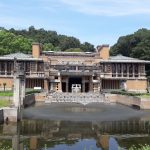WIT Life #316: Frank Lloyd Wright’s Teikoku Hotel
Written by professional Writer/Interpreter/Translator Stacy Smith (Kumamoto-ken CIR, 2000-03), WIT Life is a periodic series about aspects of Japanese culture such as film, food and language. Stacy starts her day by watching Fujisankei’s newscast in Japanese, and here she shares some interesting tidbits and trends along with her own observations.
This year marks the 150th anniversary of Frank Lloyd Wright’s birth, and celebrations are taking place around the country and world. I recently had the chance to go to MoMA’s Frank Lloyd Wright at 150: Unpacking the Archive (ending October 1 so run to check it out if you haven’t already!). This incredibly comprehensive exhibit looks at Wright’s career from 12 different perspectives, each of which has its own section. There are around 450 works that he made from the 1890s through the 1950s on display, and each section has a video narrated by a scholar in the respective field.
I was particular interested in the section discussing the second version of the Imperial Hotel (帝国ホテル), designed by Wright and built from 1919–1923). It survived the Great Tokyo Earthquake that September, but eventually slipped into decay over time and in 1967 it was decided to demolish the hotel and replace it with a high-rise building. The structure was mostly destroyed, but the iconic central lobby wing and reflecting pool were disassembled and rebuilt at Meiji-mura in Nagoya, which I was lucky enough to visit during a recent business trip.
This is an amazing theme park with a variety of architecture mostly from the Meiji Era (1868-1912), and it took over 17 years to bring Wright’s hotel there! Its destruction was finished by March 1968, and as much of the stone, tiles, and other finishing materials as possible were preserved and stored at Meiji-mura. A reconstruction site was chosen two years later, and exterior reconstruction took two years to complete. Interior reconstruction started in November 1983 after a seven-year gap, and it was finally completed in October 1985. Thanks to this accomplishment, today we can experience what it was like to stay in Wright’s grand hotel even by just traversing the lobby displaying some of the original furniture. Interestingly the hotel incorporates Mayan and other elements, and the fantastic tour guide brought the period when it was bustling back to life.
This is Wright’s most well-known structure in Japan but he actually designed 14 buildings there, only three of which remain standing. Another is the Yodoko Guest House (ヨドコウ迎賓館) built in 1924, closed until the end of next year due to repairs. The other is the School of the Free Spirit (自由学園) built in 1921, a girls’ school run by friends of Wright disciple Arata Endo. Wright and Arata collaborated so closely on the design that the final plans were signed by both of them、the first time Wright had ever shared credit with someone. It features a tall central section with soaring windows that face onto an open courtyard, with symmetrical wings on each side. A lengthy battle to save the aging structure was fought in the 1990s, with the Japanese government rewriting regulations so that the building could be used after being designated an Important Cultural Property in 1997. It is open to the public on limited days when not in use for weddings and other events, and I highly recommend a visit as it’s conveniently located in Ikebukuro.


Comments are closed.